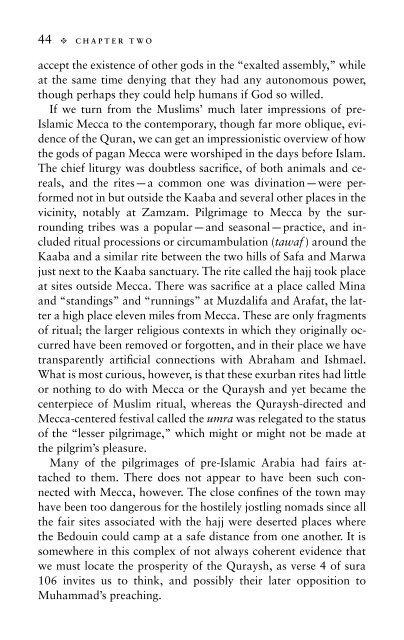Islam: A Guide for Jews and Christians - Electric Scotland
Islam: A Guide for Jews and Christians - Electric Scotland
Islam: A Guide for Jews and Christians - Electric Scotland
Create successful ePaper yourself
Turn your PDF publications into a flip-book with our unique Google optimized e-Paper software.
44 t CHAPTER TWO<br />
accept the existence of other gods in the “exalted assembly,” while<br />
at the same time denying that they had any autonomous power,<br />
though perhaps they could help humans if God so willed.<br />
If we turn from the Muslims’ much later impressions of pre-<br />
<strong>Islam</strong>ic Mecca to the contemporary, though far more oblique, evidence<br />
of the Quran, we can get an impressionistic overview of how<br />
the gods of pagan Mecca were worshiped in the days be<strong>for</strong>e <strong>Islam</strong>.<br />
The chief liturgy was doubtless sacrifice, of both animals <strong>and</strong> cereals,<br />
<strong>and</strong> the rites—a common one was divination—were per<strong>for</strong>med<br />
not in but outside the Kaaba <strong>and</strong> several other places in the<br />
vicinity, notably at Zamzam. Pilgrimage to Mecca by the surrounding<br />
tribes was a popular—<strong>and</strong> seasonal—practice, <strong>and</strong> included<br />
ritual processions or circumambulation (tawaf ) around the<br />
Kaaba <strong>and</strong> a similar rite between the two hills of Safa <strong>and</strong> Marwa<br />
just next to the Kaaba sanctuary. The rite called the hajj took place<br />
at sites outside Mecca. There was sacrifice at a place called Mina<br />
<strong>and</strong> “st<strong>and</strong>ings” <strong>and</strong> “runnings” at Muzdalifa <strong>and</strong> Arafat, the latter<br />
a high place eleven miles from Mecca. These are only fragments<br />
of ritual; the larger religious contexts in which they originally occurred<br />
have been removed or <strong>for</strong>gotten, <strong>and</strong> in their place we have<br />
transparently artificial connections with Abraham <strong>and</strong> Ishmael.<br />
What is most curious, however, is that these exurban rites had little<br />
or nothing to do with Mecca or the Quraysh <strong>and</strong> yet became the<br />
centerpiece of Muslim ritual, whereas the Quraysh-directed <strong>and</strong><br />
Mecca-centered festival called the umra was relegated to the status<br />
of the “lesser pilgrimage,” which might or might not be made at<br />
the pilgrim’s pleasure.<br />
Many of the pilgrimages of pre-<strong>Islam</strong>ic Arabia had fairs attached<br />
to them. There does not appear to have been such connected<br />
with Mecca, however. The close confines of the town may<br />
have been too dangerous <strong>for</strong> the hostilely jostling nomads since all<br />
the fair sites associated with the hajj were deserted places where<br />
the Bedouin could camp at a safe distance from one another. It is<br />
somewhere in this complex of not always coherent evidence that<br />
we must locate the prosperity of the Quraysh, as verse 4 of sura<br />
106 invites us to think, <strong>and</strong> possibly their later opposition to<br />
Muhammad’s preaching.
















